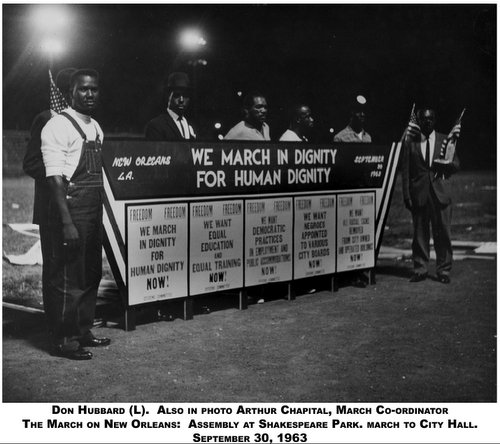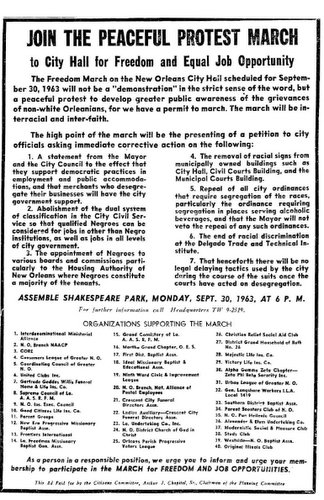
(photo courtesy of Jacques Morial)

Allan Katz and Danae Columbus
At the time, Allan was a first-year reporter at the States-Item, New Orleans’ afternoon paper. The editorial pages of The Times-Picayune and States-Item were adamantly opposed to the civil-rights movement then gaining steam throughout the South. The newspapers’ opposition to civil rights was based on the theory of “States Rights,” which held that the federal government had no right to impose an end to segregation on the sovereign states of the United States. Today, we all know how that has turned out in the last 50 years but, at that time, it was legal linchpin to the fight conducted in the courts by segregationist entities.
The serious reporting of the 1963 civil rights march was assigned to senior writers like the legendary Iris Kelso and Jack Wardlaw. The daily papers did not treat the civil rights march as a major event. Allan was just there to assist Iris and Jack. Of course, if there had been shootings, riots or fights, that would have caused the story to be played bigger.
But nothing like happened for two very good reasons. The organizers of the march were determined that it would be peaceful and the New Orleans Police Department, led by Superintendent Joseph Giarrusso, was also determined that there would be no disturbances.
The key organizers of the march were Dutch Morial, Don Hubbard, Oretha Haley, Rev. A.L. Davis, Rudy Lombard and Arthur Chapital. Dutch, who was 34 at the time, was the first black attorney to have graduated from LSU Law School and served as President of the local NAACP. Hubbard was an organizer for the CORE (Congress of Racial Equality) and Chapital, a postal worker, was a member of a family helped pioneer the civil rights movement here. Hubbard was 24 and the youngest of the organizers.
On the police side, Giarrusso assigned Henry Morris, Chief of Detectives, a very tough World War II veteran, to make sure the march was peaceful.
Of course, in later years, Morial became New Orleans’ first black mayor. Morris helped break up a police strike against the Morial administration in 1979 when neither he nor any of his detectives would join the strike. Morial would later name Morris his Police Chief. Hubbard in later years partnered with Sherman Copelin to build their political organization, SOUL, into a powerhouse that was occasionally in conflict with Mayor Morial. The then-Mayor was Victor Hugo Schiro. He won election as a segregationist in 1961 but as the 1965 election neared, he tried to make some kind of peace with the black community. While he vacillated on many of his promises, Schiro –- through the intervention of then-DA Jim Garrison and Morial –- did hire Philip Baptiste as the first African-American in an executive post at City Hall.

Original handbill from the march. (image courtesy of Jacques Morial)
In later years, Morial would tell Allan that a part of the civil-rights strategy was to get the reluctant agreement of the city’s political and business establishment to issue a parade permit to the civil-rights advocates for a peaceful march. Remembering his role in it, Morial would later tell Allan that in addressing the city’s white leadership he said that a civil rights march would allow the black community that hated segregation and all its symbols to vent their frustration and anger. Morial told Allan he did not specifically say that the alternative might not be so peaceful, because there was no need to. Everyone in the room understood that New Orleans’ black community might be approaching the point where the lid could blow off.
Many years after the march, Morris said that he and Dutch collaborated on the organization of the march but not always peacefully. Those of us who knew Dutch remember him as a very tough guy also who wanted things the way that he wanted them. Morris was equally strong willed. In one story from the day of the march, Morial came to Morris with so many complaints that Morris finally said in jest, “Dutch, if you say one more word to me, I’m going to shoot you in the head.” It is one of history’s ironies that Morial and Morris later found themselves on the same side when Morial was Mayor and when he named Morris as his Police Chief.
Today, a half century later, Hubbard, now partly retired at his lovely bed and breakfast known as the Hubbard Mansion on St. Charles Avenue, is one of the last surviving key participants in the 1963 march. It took until the mid-1970s before the last vestiges of official segregation were removed in New Orleans but the 1963 march was surely the precursor to the end of segregated New Orleans.
LABOR UNIONS SHINE AT ANNUAL PICNIC
For dozens of years the Greater New Orleans AFL-CIO has held an annual Labor Day Picnic at City Park. This year’s event broke all attendance records and drew a big, diverse crowd of more than 1,200, including judicial candidates, elected officials and union leaders from boilermakers, to building traders, to teachers to hospitality workers. The year’s event even had corporate sponsors, including Pepsi-Cola. Of course all the Union-endorsed candidates spoke and their future choices for the winter races were introduced.
GEORGES STRUTS HIS STUFF WITH BENSON PARTNERSHIP
Wednesday evening’s lovefest at the Superdome where the Benson and Georges’ family sealed their long-term relationship shows just how savvy a politician Georges still is. He is quickly taking over the spot in the community held by former TP Publisher Ashton Phelps for many decades. And media from across the city – even the Associated Press – were on hand to take in the event.
The women rulers include Advocate co-owner Dathel Georges and Rita Benson LeBlanc, the brains behind the merger. Between that relationship and the Advocate’s relationship with LSU, John never has to worry about where to sit at a game!
Allan Katz spent 25 years as a political reporter and columnist at The Times-Picayune, and is now editor of the Kenner Star and host of several televsion programs, including the Louisiana Newsmaker on Cox Cable. Danae Columbus is executive producer of Louisiana Newsmaker, and has had a 30-year career in public relations, including stints at City Hall and the Dock Board. They both currently work for the Orleans Parish School Board. Among the recent candidates who have been represented by their public relations firm are City Councilwoman Stacy Head, Lt. Gov. Jay Dardenne and council candidate Dana Kaplan.